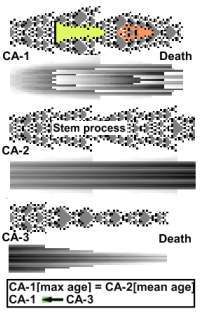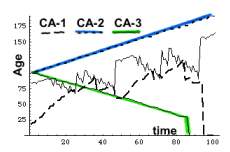 |
Stem process
In the last experiments
a three CA system differentiated and blossomed. Finally
two CA died and only one
continued living. Here
we demonstrate that by diverting more resources (age) to the declining CA, at least one can be rescued. Below
are three CA and their age structures. CA-2[mean age] sets max age
of CA-1. CA-3 diverts its age increment to CA-1
 |
 |
In the following experiment CA-2 donated its age increment to CA-3, and its aging velocity = 0. Consequently CA-3 aging declined less steeply. Upon CA-1 death, CA-2, and CA-3 stopped transferring their age increments to CA-1 and their ages started rising. CA-3 was rescued.
 |
Stem process
In both experiments CA-2 did not differentiate, and its
cells did not die. CA-2 is an undifferentiated stem process, which maintains the system, otherwise it would die.
Stem process may donate its age increment to other processes, however its age never drops below one.
Further reading:
Streaming tissues
Setup
nca=3; zygote
-> effect[no 1000]; go[17]; go109]; restoreparams; effect[1, nowdat[[2, 7]], 0]; donate[1, 3];
donate[1, 3]; go [100]; restoreparams; effect[1, nowdat[[2, 7]],
0]; donate[1, 3]; donate[1,
3]; donate[1, 2]; go [100];